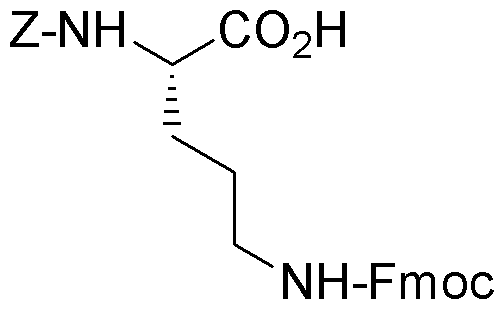Na-Z-Nd-Fmoc-L-ornithine is widely utilized in research focused on:
- Peptide Synthesis: This compound serves as a key building block in the synthesis of peptides, particularly in the development of therapeutic agents and vaccines.
- Drug Development: Its unique structure allows for the creation of modified peptides that can enhance drug efficacy and specificity, making it valuable in pharmaceutical research.
- Bioconjugation: The chemical is used in bioconjugation processes to attach biomolecules to drugs, improving delivery systems and targeting capabilities in cancer therapies.
- Research in Neuroscience: It plays a role in studying neuropeptides, contributing to our understanding of neurological disorders and potential treatments.
- Cosmetic Formulations: The compound is also explored in cosmetic chemistry for its potential benefits in skin care products, particularly in anti-aging formulations.
General Information
Properties
Safety and Regulations
Applications
Na-Z-Nd-Fmoc-L-ornithine is widely utilized in research focused on:
- Peptide Synthesis: This compound serves as a key building block in the synthesis of peptides, particularly in the development of therapeutic agents and vaccines.
- Drug Development: Its unique structure allows for the creation of modified peptides that can enhance drug efficacy and specificity, making it valuable in pharmaceutical research.
- Bioconjugation: The chemical is used in bioconjugation processes to attach biomolecules to drugs, improving delivery systems and targeting capabilities in cancer therapies.
- Research in Neuroscience: It plays a role in studying neuropeptides, contributing to our understanding of neurological disorders and potential treatments.
- Cosmetic Formulations: The compound is also explored in cosmetic chemistry for its potential benefits in skin care products, particularly in anti-aging formulations.
Documents
Safety Data Sheets (SDS)
The SDS provides comprehensive safety information on handling, storage, and disposal of the product.
Product Specification (PS)
The PS provides a comprehensive breakdown of the product’s properties, including chemical composition, physical state, purity, and storage requirements. It also details acceptable quality ranges and the product's intended applications.
Certificates of Analysis (COA)
Search for Certificates of Analysis (COA) by entering the products Lot Number. Lot and Batch Numbers can be found on a product’s label following the words ‘Lot’ or ‘Batch’.
Numéro de catalogue
Numéro de lot/série
Certificates Of Origin (COO)
This COO confirms the country where the product was manufactured, and also details the materials and components used in it and whether it is derived from natural, synthetic, or other specific sources. This certificate may be required for customs, trade, and regulatory compliance.
Numéro de catalogue
Numéro de lot/série
Safety Data Sheets (SDS)
The SDS provides comprehensive safety information on handling, storage, and disposal of the product.
DownloadProduct Specification (PS)
The PS provides a comprehensive breakdown of the product’s properties, including chemical composition, physical state, purity, and storage requirements. It also details acceptable quality ranges and the product's intended applications.
DownloadCertificates of Analysis (COA)
Search for Certificates of Analysis (COA) by entering the products Lot Number. Lot and Batch Numbers can be found on a product’s label following the words ‘Lot’ or ‘Batch’.
Numéro de catalogue
Numéro de lot/série
Certificates Of Origin (COO)
This COO confirms the country where the product was manufactured, and also details the materials and components used in it and whether it is derived from natural, synthetic, or other specific sources. This certificate may be required for customs, trade, and regulatory compliance.


